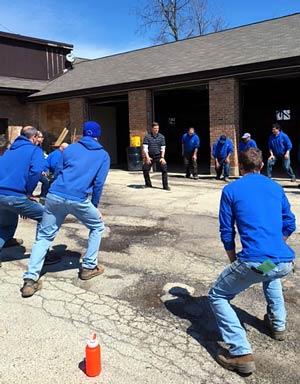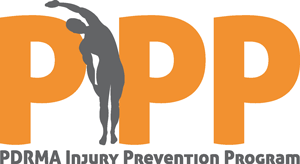 Putting the “Action” in Plans of Action Putting the “Action” in Plans of Action A key tool in continuous safety improvement is a well-crafted and implemented Plan of Action (POA). POAs — incorporated into the Loss Control Review process — help members stay focused throughout the year on reducing injuries and minimizing losses.
At Elmhurst Park District, POAs have been a successful part of the agency’s risk management efforts for the past few years. “Since our 2012 Loss Control Review, we’ve had several POAs that Jesse Kinsland, our PDRMA Risk Management Consultant, coordinated with us,” says Julie Bruns, Division Manager of Human Resources and Risk. The plans included ergonomic assessments, implementation of a stretching program and a flood evaluation of the Courts Plus fitness center.
“In 2012, we scored a 99.5 percent on our Loss Control Review,” Bruns notes. “That’s when PDRMA asked us to ‘step it up’ and take our risk management program to the next level, which is what many of our POA recommendations help us do.” Bruns proudly points out that Elmhurst was among the first to develop a stretching program. “It’s become a model for other members — and the best part is, our program is still active!”
Making POAs work at Elmhurst is a collaborative effort among Bruns, Kinsland, the agency’s Safety Committee and other key staff. Once created, the POA becomes part of Bruns' work plan. “I determine who else at the agency needs to be involved to help us reach the goal. Sometimes we bring in a vendor, but most often it’s our employees working together to complete the project.”
Workers’ compensation and storm-related claims account for the largest losses at the agency, and the POAs have been making slow and steady progress.
 “Since the PIPP and Core 6 programs focus on employee safety, it made sense for them to be key to our POAs addressing workers’ compensation risks,” Bruns says, noting that Kinsland provides helpful advice to create the plans. “The best part is that he’s available throughout the year to answer any questions or offer suggestions and solutions.” “Since the PIPP and Core 6 programs focus on employee safety, it made sense for them to be key to our POAs addressing workers’ compensation risks,” Bruns says, noting that Kinsland provides helpful advice to create the plans. “The best part is that he’s available throughout the year to answer any questions or offer suggestions and solutions.”
The Park District of Highland Park also realized the value of the PIPP and Core 6 programs in promoting a strong safety culture at the agency through its Plans of Action.
“Our last POA focused on those programs,” reports Megan Kulling, Safety Coordinator. “We knew how important starting the PIPP program was and were excited to get it in place, have staff learn the benefits, and then incorporate it into their work day. Everything in our POA related directly to Core 6 and PIPP goals.
“We had some larger workers’ comp claims and we wanted to avoid future repeats,” she explains. “We knew if staff had the proper tools (i.e., education and techniques), it would decrease the chance of injuries.” That was the impetus for a POA for a formal stretching program.
“We started out slowly, introducing the key PIPP elements and getting staff buy in. At first, we identified just two areas in which to make the stretching program mandatory, and then we expanded it from there.”
The agency brought in Dr. Jim Clapper, Ergonomics Specialist, to teach a hands-on class for tennis and park maintenance staff. “After everyone knew the key components of PIPP, we started stretching as a staff every morning,” says Kulling. “To reinforce this, we had everyone use the Job Task Coaching and Redirecting form — not just supervisors. The form supports the PIPP training and ensures we maintain consistent safety practices out in the field.”
The PIPP program as a whole has been a success for the district, Kulling reports. “When the program started, we stretched in the morning as a group. Now that employees see the benefits, they are making a conscious effort to stretch throughout their day.
“Our safety culture is changing to be more cognizant of ergonomics and of the many benefits of stretching. PDRMA has always been a strong partner in keeping us safe and is always willing to assist with implementing the POA to ensure we understand what we need to do to be a safe and successful member.” |

